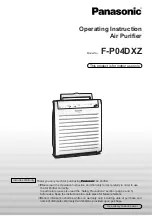
11
■
English
Refrigerant piping work
2.
Refrigerant piping.
1) Align the centres of both flares and tighten the flare
nuts 3 or 4 turns by hand. Then tighten them fully with
the torque wrenches.
• Use torque wrenches when tightening the flare nuts to
prevent damage to the flare nuts and escaping gas.
2) To prevent gas leakage, apply refrigeration machine oil on
both inner and outer surfaces of the flare. (Use refrigeration oil for R410A)
2-1. Caution on piping handling.
1) Protect the open end of the pipe against dust and moisture.
2) All pipe bends should be as gentle as possible. Use a pipe bender
for bending.
(Bending radius should be 30 to 40 mm or larger.)
2-2. Selection of copper and heat insulation materials.
• When using commercial copper pipes and fittings, observe the following:
1) Insulation material: Polyethylene foam
Heat transfer rate: 0.041 to 0.052 kW/mK (0.035 to 0.045 kcal/(mh •°C))
Refrigerant gas pipe’s surface temperature reaches 110
°
C max.
Choose heat insulation materials that will withstand this temperature.
2) Be sure to insulate both the gas and liquid piping and to provide insulation dimen-
sions as below.
3) Use separate thermal insulation pipes for gas and liquid refrigerant pipes.
Gas side
Liquid side
Gas pipe thermal
insulation
Liquid pipe
thermal insulation
25/35 class
25/35 class
O.D. 9.5mm
O.D. 6.4mm
I.D. 12-15mm
I.D. 8-10mm
Thickness 0.8mm
Thickness 0.8mm
Thickness 10mm Min.
Flare nut tightening torque
Gas side
Liquid side
3/8 inch
1/4 inch
32.7-39.9N
l
m
14.2-17.2N
l
m
(333-407kgf
l
cm)
(144-175kgf
l
cm)
Coat here with refrigeration machine oil
Torque wrench
Piping union
Flare nut
Spanner
Wall
If no flare cap is
available, cover
the flare mouth
with tape to keep
dirt or water out.
Be sure to
place a cap.
Rain
Gas pipe
Liquid pipe
Gas pipe
insulation
Liquid pipe
insulation
Finishing tape
Drain hose
Inter-unit wiring
01_EN_3P142639-1.fm Page 11 Monday, October 11, 2004 3:59 PM
Содержание FTXS20DVMW
Страница 15: ...0411 HT 3P142639 1 M04B040...

































